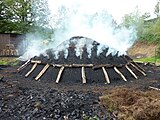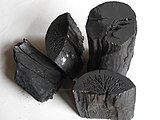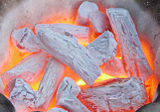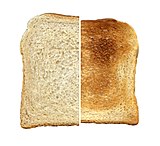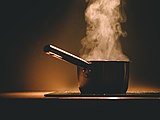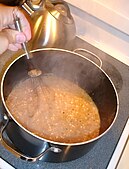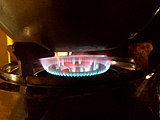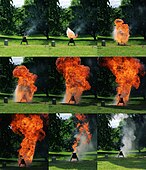
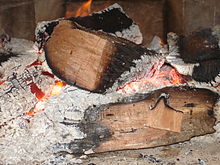
- At low temperature, volatiles, including some water, evaporate; some changes, such as denaturation (unfolding of proteins) occur below boiling point, but many organic compounds are stable
- Not until all the water has boiled off can the temperature rise above the boiling point. This consumes a lot of energy.
- At sufficiently high temperatures, the organic molecules thermally degrade, releasing chemically-altered organic molecules and more volatiles, which leave as smoke. Generally, this process also absorbs energy. Carbon is left behind, and the material becomes black and charred.
- As temperatures rise further, pyrolysis continues, but more reactions become possible. Carbon can now combine with oxygen, a highly exothermic reaction. The released heat allows more carbon to combine with oxygen, and the reaction can more easily become self-sustaining. Most organic matter contains a few percent nitrogen, which can oxidize as nitrogen oxides, NO2 and NO3.
- Finally, the material is reduced to a whitish ash. This has only a fraction of the volume and weight of the original organic material, as the water, carbon, and minor constituents have largely left in the smoke (as gas, droplets, and particulate matter).
Charcoal and ash
-
Charcoal is produced by partly burning wood at a low temperature, pyrolyzing it, and releasing most of the volatiles, but without oxidizing most of the carbon. This process is called charcoal burning. Shown is a shored clamp, with finished charcoal in the foreground. Volatiles and pyrolysis products are escaping, but most of the carbon will not be oxidized.
-
A charcoal-burner tending his charcoal clamp, in which he is producing charcoal. The process takes days, and the clamp has to be monitored to stop the fire from breaking out (well, the oxygen from breaking in).
-
Expensive Japanese oak charcoal. The wood has been carbonized, and the resulting charcoal is therefore black, right through. The charcoal is also much lighter-weight (mostly because the water has left).
-
Bamboo charcoal, probably cheaper. Charcoal can be made of most organic material; husks, leaves, grass, nut shells... If the size of the material is inconvenient, it can be powdered and compressed into briquettes. The silvery sheen may be silica.
-
Artist's charcoal is traditionally made of pencil-sized willow sticks, grape vines, or European spindlewood sticks (the last is shown here). The char is a deep black, and is used for sketching.
-
A charcoal fire; charcoal is a lower-smoke fuel than wood, as much of the pyrolysis products have already been released, and oxidizing the carbon produces only CO2 (and CO, if there is a lack of oxygen).
-
Charcoal briquettes, often made from compressed sawdust or similar, in use. Some cities ban, or used to ban, wood fires; when residents only use charcoal (and similarly-treated rock coal, called coke) air pollution is significantly reduced. In cities where people do not generally cook or heat with fires, this is not needed.
-
The surface of these charcoal logs, initially black, is now white ash
-
Ashes of a cardboard box. Ash is non-flammable. It is the residue that cannot be burned.
Baking
-
Bread dough. Denaturation occurs at temperatures below boiling, and is responsible for a lot of low-temperature cooking reactions (like dough turning into bread, or meat becoming firm, or eggs solid).
-
Baking bread. Bread is baked at temperatures above boiling, but is not baked for long enough to drive off the water (except partly, in a thin crust on the outside, which therefore browns).
-
If bread is left for too long, it will dry out and carbonize. This pizza is charred; it was baked in an oven for four hours. The temperature was probably too low for oxidative combustion.
-
Patchily charred bread. If the bread is baked slowly at lower temperatures, it will be paler; if it is baked too long, it will char and blacken from the outside in.
-
If a slice of bread is toasted, the face will first brown, and then blacken; in slightly burnt toast, the thin layer of char can be scraped off.
Cooking
-
In this glass container, water near the bottom surface is vapourized, forming bubbles, which then rise to the top.
-
Water vapour pot hits cooler air and condenses, forming fine droplets; the aerosol of these droplets is wet steam.
-
A woman stirs sorghum porridge to stop if from sticking. If the food in the pot is too thick, new liquid water cannot reach the bottom of the pot to cool it. Unless the pot is stirred soon, all the water in the bottom layer boils off. The layer of food nearest the bottom of the pot dries out, its temperature rises above the boiling point, and it chars. The food burns to the bottom of the pot.
-
Caramelizing onions, with carrots and celery. Frying oil can easily rise above boiling point, and food left in it for long enough to dry out can char (for instance, caramelized onions are slightly charred). Putting a lid on the frying pan keeps the water in, and some of it re-condenses, keeping the temperature lower for longer.
-
Deliberately charred onions
-
Sugar that has melted and charred somewhat (carmelized) under a flame. Sugar can be made to oxidatively combust.
Flame and smouldering
-
A gas burner. Flames are a burning gas or aerosol. They occur when the gasses (or liquid droplets in a gas) burn.
-
Gas and liquid aerosol are still burning and glowing as they stream away from the solid wood in this campfire.
-
In a chip pan fire, the oil is heated too much, and it auto-ignites, with the carbon in the oil oxidizing.
-
If water is poured into the pan, it will sink to the bottom, because oil is less dense than water and thus floats.
-
Both the bottom of the pan and the oil are far above boiling point, meaning that the water will heat and flash to steam
-
The steam erupts from the pan, pushing the flaming oil out ahead of itself and breaking it into droplets
-
The steam-oil aerosol, suddenly spread out and exposed to air, will all ignite at once, making a large fireball. Indoors, this can ignite the ceiling space
-
An outdoor demonstration. In the first image, the oil catches fire, and the water is just being added. In the second image, a small white cloud of droplets explodes from the flaming pot; in the following images, the cloud expands, but the flames spread to almost completely conceal it, and the cloud of flame disappears out of the top of the fram. In the last two images, the flame dissapates, leaving a cloud of smoke. Elapsed time 2.4 seconds.
-
A narrated demonstration of a small boilover, using 125mL (half a cup) of oil. Boilover fires often cause injury and death. Note that when no water is dded, the flames are comparatively small, as only a small amount of combustible material is aerosolized (I don't think he's right about hydrolysis, as the fire would not then need an air supply).
-
In an oil lamp, a small amount of oil is wicked into a strip of absorbant material, exposing more surface area to the air, and the end of the strip is set alight. The oil reservoir remains too cool to burn.
-
Smouldering embers glow from the heat released by oxidative combustion. A fire in which there is no visible flame, and the combustion takes place in or near the solid, is referred to as a smouldering fire.
Other terms edit
- "Complete combustion" refers to material being reduced to non-flammable ash
- "Oxidative combustion" is combustion involving oxidation
The word "combustion" is taken by some to cover only oxidative combustion, or only self-sustaining exothermic reactions. The word "burned" is commonly used to refer to things that are only charred, as well as those that are oxidatively combusting, such as burned food and a burning log.
- "Pyrolysis", literally "fire-breaking", refers, in organic materials, to the breaking-apart of large organic molecules under heat. Pyrolysis products may be smaller organic molecules or inorganic molecules.
- "Charring" is the blackening of carbonization; carbonized material is called "char". "Charcoal" is lumps of char, usually used as a fuel.
- "Distillation" is a chemist's term for separating materials with different boiling points by boiling only one of them, then taking the vapour somewhere eise to cool.
- "Destructive distillation" is a parallel term for separating out a material by pyrolysing the mixture, then taking the smoke elsewhere. In some cases (i.e., separating sugar and glass) then one material might already have been present, but it can also be used to split the desired molecule out of a larger one.
